Luthers Wedding in Wittenberg
Luthers Wedding in Wittenberg
LUTHERS HOCHZEIT
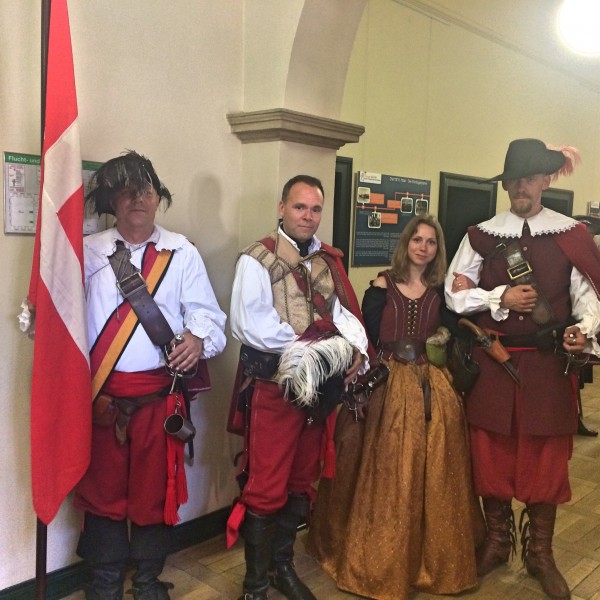
Danish delegation from Haderslev – Wittenberg
Visited by Henning Høholt
WITTENBERG/GERMANY: One of the summer hits in Wittenberg, Germany is the Middle Age market, which was arranged 9.-11th June, in the beautiful city of Wittenberg, Germany, where the hit is the parade Saturday at 14.00 called Martin Luthers Wedding, where thousand of participants in middle age costumes are making a longa parade through the beautiful city center, inclusive participants, suppose to play the roles as Martin Luther and his wife Katarina von Bora
. The authorities in the city tells that 100.000 visitors was expected to be present at this market day, and the small city streets were packed.
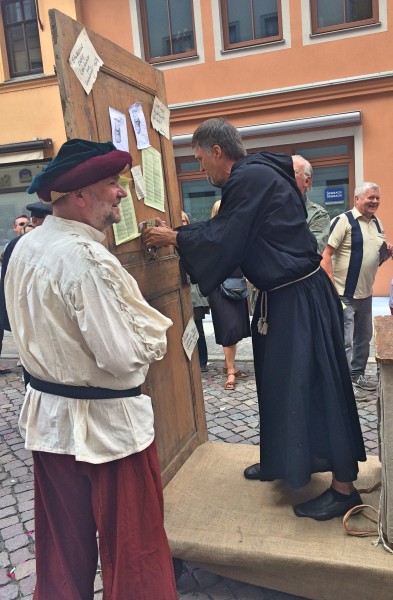
In the Historical Parade:”Luther”, hanging up the95 theses at the All Saints Church Church door in 1517.
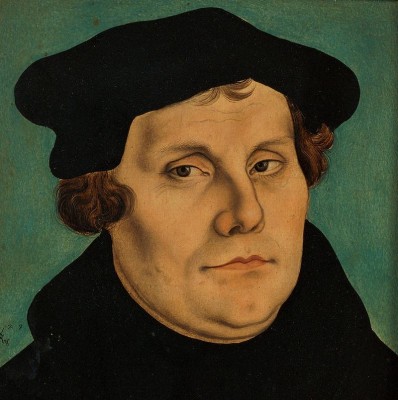
Martin Luther, German; 10 November 1483 – 18 February 1546), O.S.A., was a German professor of theology, composer, priest, monk, and a seminal figure in the Protestant Reformation. – Cranach painting from 1529.
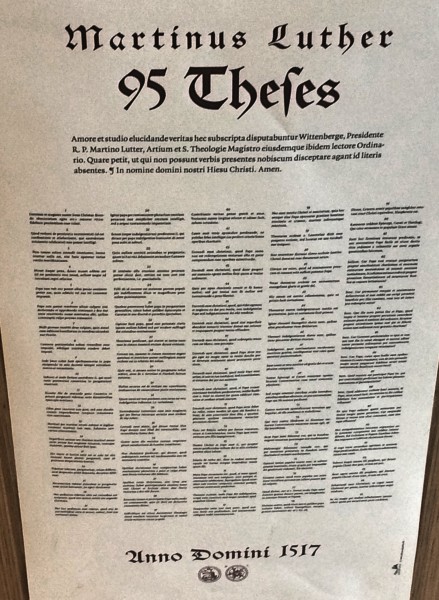
Martin Luther 95 theses, that he put op on the church door in Wittenberg.
Many beautiful and time right costumes were presented, it was in deed a bi´g event, and a success, and the weather was first class, warm sunshine
.
However. The rest of the year Wittenberg has a lot of experiences to show. The old city center, its museums:
Historical Parade
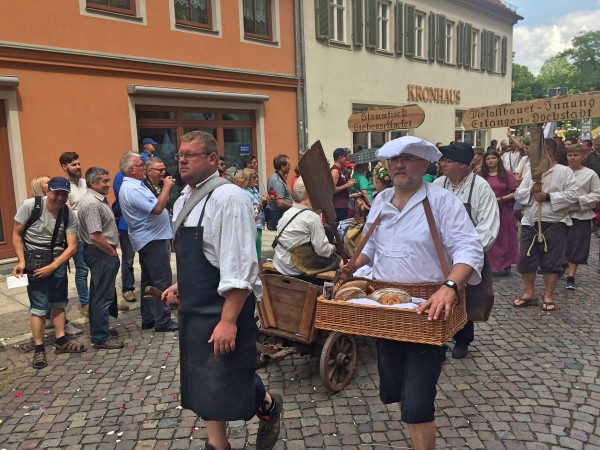
Bakers in the parade
In the Great Historical Parade in the old city center of Wittenberg, which took nearly one hour, to get all the different parts through the slim streets, we noticed all kind of interesting participant groups.
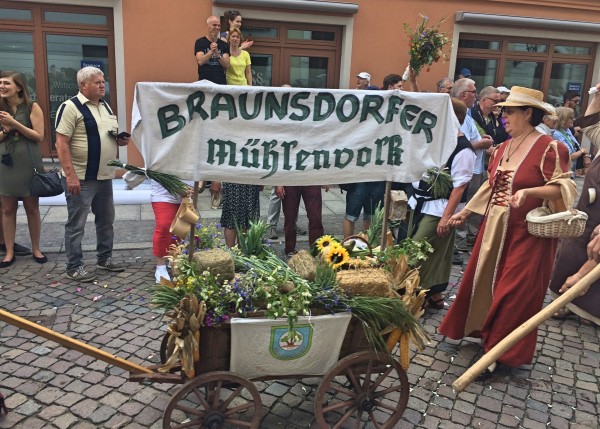
Brauensdorfer Muhlenvolk
Of course with a couple representing and dressed up like Martin Luther and his wife Katharina von Bora, who in this 2017 parade, was performed by Bernhard Nauhman and Katja Köhler.
It all opened by the Wittenberger City Captain with his city guard and brave men. Followed by The Electoral Court inclusive kurfürst Friedrich, Kurfürst August. Kurfürst Joachim II, and also Christine von Sachsen and her daughter Elisabeth von Denmark , Norway and Sweden. – Noble ladies of the Electoral Court, (draft Association Wittenberg). Inclusive different musical cops in uniforms. Members of Lucas Cranachs household. Representatives from the Wittenberg University. A very amusing and entertaining parade
.
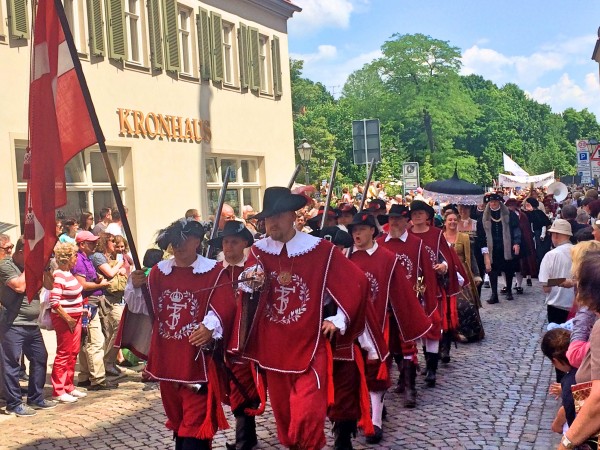
Danish delegation from Haderslev at Luthers Wedding parade in Wittenberg.
Kulturkompasset had the great pleasure of visiting this beautiful old city during the middle Age markets hold in the city this year 9.-11-June. Including the Historical Parade – Luthers Wedding. However this old city have so many interesting attractions for tourists, that we have decided to split this reportage up in more than one history, as it will give us possibility to enlarge each reportage a bit, and ad some of the many photos, that we photographed by our self, or we received from the Wittenberg Tourism and Saxony Tourism offices.
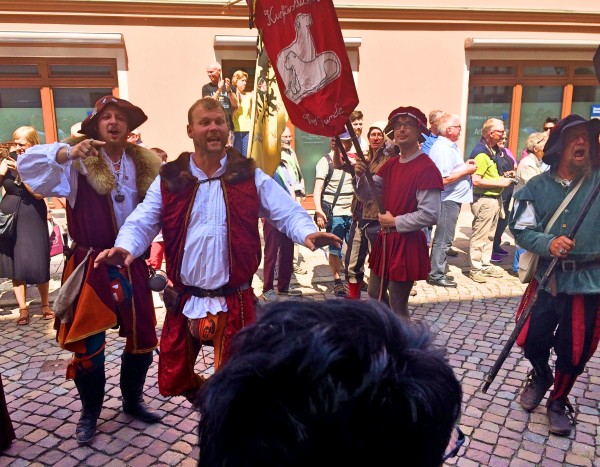
Funny Gues in Wittenberg Parade.
The importance of Wittenberg historically was due to its seat of the Elector of Saxony, a dignity held by the dukes of Saxe-Wittenberg and also to its close connection with Martin Luther and the dawn of the Protestant Reformation; several of its buildings are associated with the events of this time.
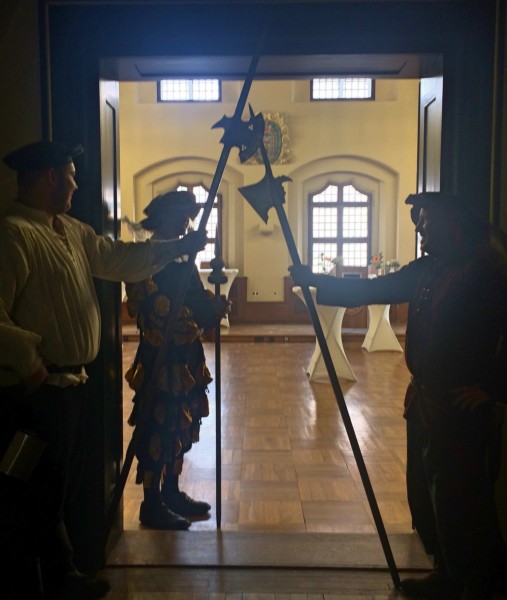
Guards at Wittenberg City Hall.
Part of the Augustinian monastery in which Luther dwelt, first as a monk and later as owner with his wife Katharina von Bora, and family, is preserved and considered to be the world’s premier museum dedicated to Luther. Various Luther and Melanchthon memorial sites were added to the UNESCO world heritage list in 1996.
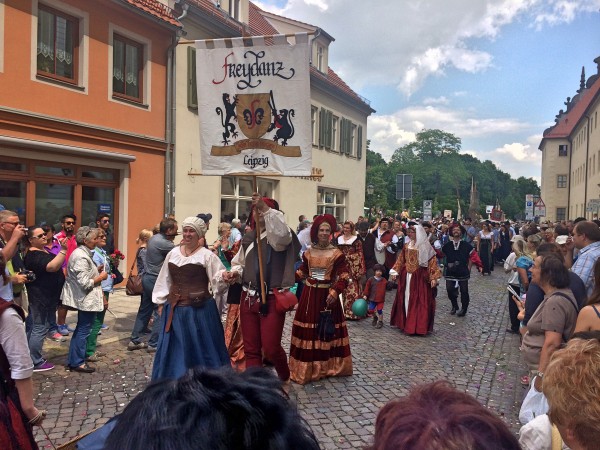
FREUTANZ Group, dancing the Parade.
Stadtkirche on the Market Square, is the center of the old city part.
Main sights in Witttenberg:
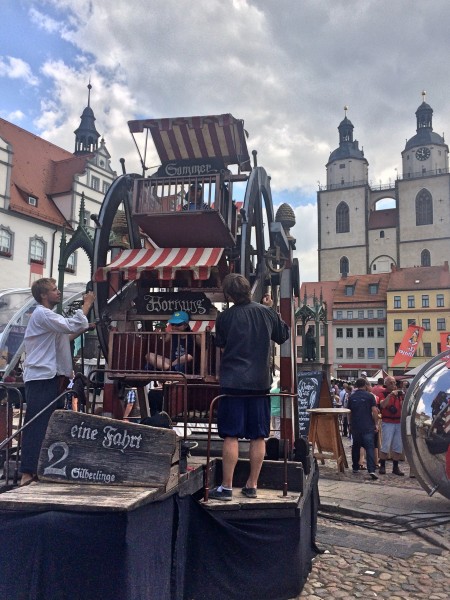
Carousel at Main Square – Wittenberg
Wittenberg is home to numerous historical sites, as well as portraits and other paintings by Lucas Cranach the Elder and Younger. On the doors of All Saints’ Church, the Schlosskirche (“castle church”, built in 1496–1506) Luther is said to have nailed his 95 theses in 1517. After damaged by fire in 1760 during a bombardment b during the Seven Years’ War, it was later (1885–1892) restored. The wooden doors, unfortunately burnt in 1760, were replaced in 1858 by bronze doors, bearing the Latin text of the theses.
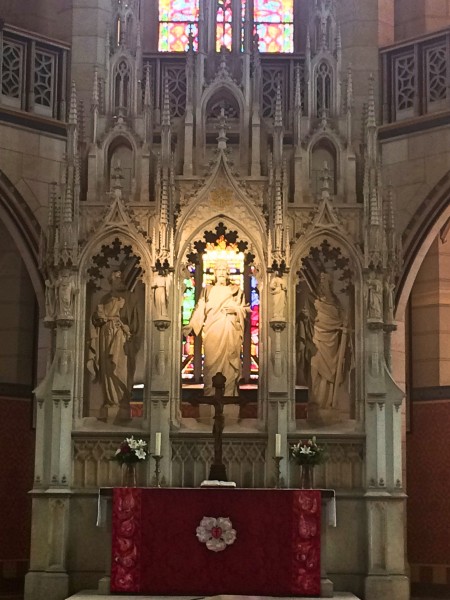
Alter All saints Church, Wittenberg
Inside the church are the tombs of Luther and Philipp Melanchthon, and of the electors Frederick the Wise (by Peter Vischer the Younger, 1527) and John the Constant (by Hans Vischer), and portraits of the reformers by Lucas Cranach the Younger.
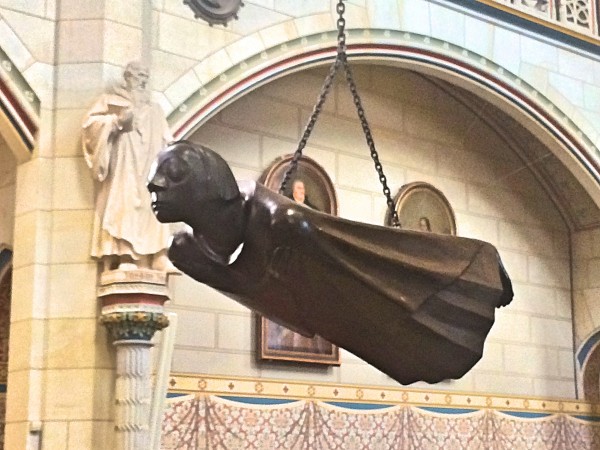
Ernest Barlach sculpture in All Saints Church, a part of the exposition inside in the Castle with his and Käte Kollwitz pictures and sculptures.
St. Mary’s Church, the parish church in which Luther often preached, was built in the 14th century, but has been much altered since Luther’s time
. It contains a painting by Lucas Cranach the Elder, representing the Last Supper (with the faces of Luther and other reformers), Baptism and Confession, also a font by Hermann Vischer the Elder (1457). In addition, there are numerous historic paintings in the church.
The ancient electoral palace is another of the buildings that suffered severely in 1760; it now contains archives.
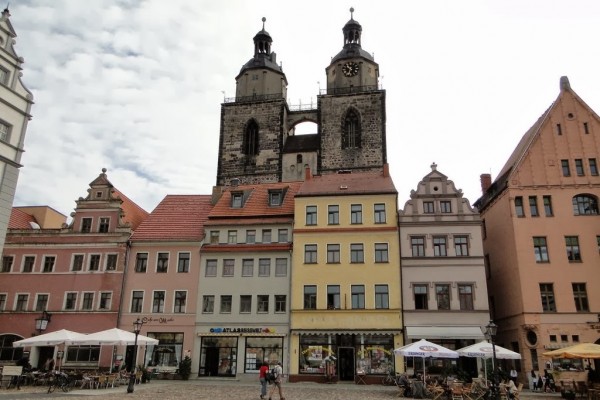
Stadtkirche on the Market Square. Wittenberg. At this photo the Maret Place is empty, but during the Middle Age Market, this square was completely packed. See the picture above, with a lot of Activities. However, we wanted to show the interesting and atmospheric architecture, when the city is not packed with tourists.
Martin Luther’s home, the Lutherhaus, where he studied and lived both before and after the Reformation, is now a museum containing many artifacts from his life. Melanchthon’s house and the house of Lucas Cranach the Elder, mayor of Wittenberg, can also be found here. Statues of Luther (by Schadow), Melanchthon and Bugenhagen embellish the town. The spot outside the Elster Gate where Luther publicly burned the papal bull in 1520 is marked by an oak tree.
In Die Grüne Gewellbe in the Castle of Dresden, we found lately two interesting details connecting to the theses that Luther on 31 October 1517, nailed to the church door of the All Saints church in Wittenberg. The sabel belonging to Luther, and the hat of the bishop.
– – – – –
Martin Luther and the Reformation is celebrated with Event Highlights during 2017-2018 in the State of Saxony – State of the Arts, and many other places i Europe, lately we noticed it in Strasbourg (France) during a vist.
An interesting detail: Extra many tourists are during the Reformation jubilee expected to this part of Germany, also this year, but for example in Wittenberg, we were told, that normally at the tourist information is 7- 8 persons working, this year the staff is developed up to 25 persons. This gives an idea of how important the interest for the Reformation is in the world to day. – Not that it perhaps changed so mush in the world situation, but it exist.
Furthermore, we shall not go deeply in to all the history about Wittenberg, as it can all be read by visiting Wikipedia: https://en.wikipedia.org/wiki/Wittenberg
We shall make a photo reportage, mostly from our own visit.
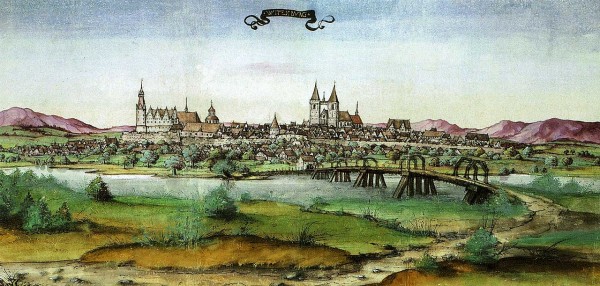
Wittenberg in 1536, during the lifetime of Martin Luther – Martin Luther, German; 10 November 1483 – 18 February 1546), O.S.A., was a German professor of theology, composer, priest, monk, and a seminal figure in the Protestant Reformation.
HISTORY of Martin Luthers 95 theses:
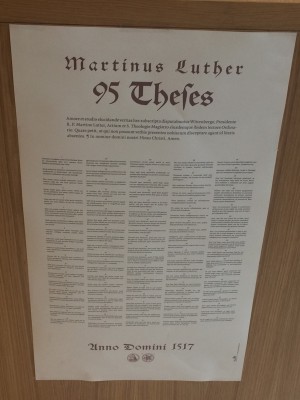
Martin Luthers 95 Theses.
On 31 October 1517, Luther nailed his 95 theses against the selling of indulgences at the door of the All Saints’, the Castle Church – an event taken as marking the beginning of the Protestant Reformation.
The Anabaptist movement had one of its earliest homes in Wittenberg, when the Zwickau prophets moved there in late 1521, only to be suppressed by Luther when he returned from the Wartburg in spring 1522.
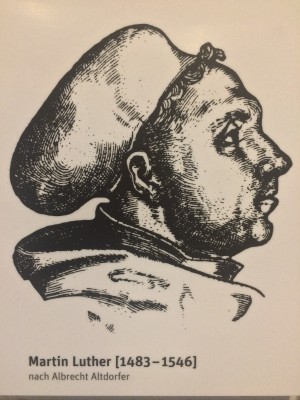
Martin Luther- By Albrecht Altdorfer
The Capitulation of Wittenberg (1547) is the name given to the treaty by which John Frederick the Magnanimous was compelled to resign the electoral dignity and most of his territory to the Albertine branch of the House of Wettin.
